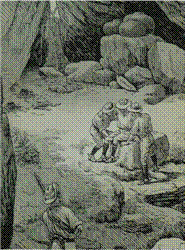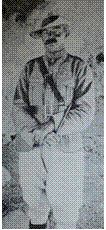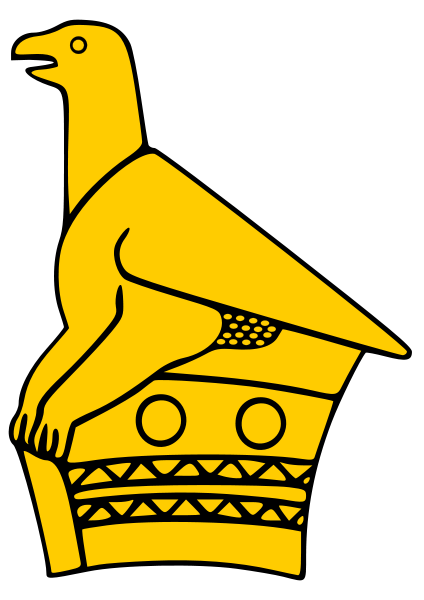Pioneer Days
2011 was the 115th anniversary of the First Chimurenga (or Umvukela as it is known in Matabeleland). Throughout that year, the Zanj Financial Network 'Zfn', in Harare, Zimbabwe, prepared a number of historical reports briefing on this bloody uprising that resulted in much attritution and misery on both sides, some of which are reproduced here.
This briefing takes us into two of Zimbabwe's most sacred landscapes – Ntaba-zi-ka-Mambo and the Matobo Hills. By this stage of the 1896 war, the whites were on the offensive – but victory was hardly assured and peace seemed all but impossible. As the war entered this phase, no quarter was given, or asked for.
What was the tactical situation?
As noted in a previous briefing, the Matabele had lost the initiative by the end of April 1896. The whites had been reinforced with Imperial troops and resupplied with ammunition and food; they were spoiling for a fight too. Selous (1896: xvii) wrote about his memory and perception of the mood: “they were the avengers of the women and children of their colour... and that fighting as they were against hordes of savages... nothing else could be expected than that in the hour of victory no quarter should be given to the murderous foe”. The Matabele were as determined not to surrender and nothing better demonstrates the Matabele commitment to seeing the war through than their stockpiles of food, weapons and ammunition.
What did they have?

A cave stronghold in the Matopos. (Note the grain baskets at the back) Baden-Powell 1897
Other than their traditional weapons – assegai, induku, and shield, the Matabele had a bewildering variety of old muzzle-loading rifles. A fair portion of the army were armed with modern breech-loading rifles, amongst which Martini Henrys, Winchesters and Lee Metfords figured prominently (see Box 1). Cobbing (1976: 193-196) and Clarke (2010) have convincingly demonstrated that the majority of these weapons and ammunition entered the country before 1893 although supplies may have increased during 1894-1895. Cobbing argues that they had stockpiled enough ammunition for a campaign lasting between four to six months and when the expected easy victory did not materialise, tactics were forcibly modified.
And food supplies?
The Matobo Hills and Ntaba-zika-Mambo are liberally littered with the remains of grain bins. These stout clay cylinders have been used by people for centuries to safely and reliably store a variety of foods away from the depredations of raiders and natural pests. New research (Hubbard 2011) has indicated that the building of such structures seems to have increased in the time before the War and during the withdrawal into these sanctuaries. Part of the strategy behind the Matabele siege of the main urban centres was to allow the harvest to continue although this would prove to be difficult once the whites broke out and began to loot and burn much of the stored grain in an effort to starve the army into submission. It worked to an extent but one of the reasons the Matabele agreed to negotiate was to end the war in time for the planting season (September-October).
Who were the main white commanders?

Major Herbert Plumer
The arrival of Imperial troops and relief forces from the north changed the face of the military campaign, not least due to the new men in charge; professionals for the most part and unencumbered by the emotional baggage the Bulawayo forces had. The notables included:
- Officer Commanding Major General Carrington
- Frederick Carrington joined the army at the age of 20 and served in many campaigns in South Africa before becoming Commanding Officer of the Bechuanaland Border Police. Arriving in Bulawayo in June 1896 he took command of all military forces in the area. Ransford (1968: 106) writes that he was “now a swollen caricature of the dashing cavalry officer who had won renown in innumerable colonial wars and... [he was likely] given this job because he was one of the few regular officers who could get on well with Rhodes”.
- Major Plumer
- Herbert Charles Onslow Plumer was a small man, retiring and quiet. He kept to himself and made little effort to become more popular with his men. He was seriously short-sighted and wore a monocle that he would fix to his eye and glare at any offender. He was always neatly dressed and remained a stickler for hygiene all his life. His reserve was often interpreted by his soldiers as indecisiveness though many would later come to respect his cautious but practical analysis of any situation. Stent (1925: 31) claimed that he “inspired his men with extraordinary confidence”.
- Chief of Staff Lieutenant-Colonel Baden-Powell
- Robert S.S. Baden-Powell was born in 1857 and unlike the rest of his siblings, proved a poor scholar. Failing to gain entry to Oxford, Baden-Powell excelled in the Army entrance exam and was immediately gazetted into the ranks. BP has been described as “a fine actor, and a born wit, and to the qualities, combined with his amazing versatility and excellent spirits, he owes his popularities and success”. Before arriving in Matabeleland, BP had already seen action in India, Zululand and Ghana.
The military men mentioned in the last briefing continued to play an important role for the rest of the war in Matabeleland but ceded almost all authority to the Imperial forces.
Sourced from the Zanj Financial Network 'Zfn', Harare, Zimbabwe, email briefing dated ? 2011


 South Devon Sound Radio
South Devon Sound Radio Museum of hp Calculators
Museum of hp Calculators Apollo Flight Journal
Apollo Flight Journal Apollo Lunar Surface Journal
Apollo Lunar Surface Journal Cloudy Nights Classic Telescopes
Cloudy Nights Classic Telescopes The Savanna - Saffer Shops in London
The Savanna - Saffer Shops in London Linux Mint
Linux Mint Movement for Democratic Change
Movement for Democratic Change